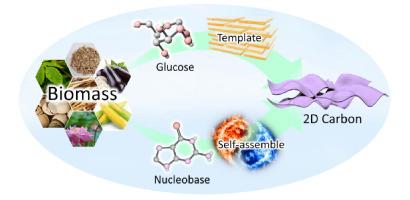Journal of Energy Chemistry ( IF 14.0 ) Pub Date : 2020-06-26 , DOI: 10.1016/j.jechem.2020.06.033 Baobing Huang , Yuchuan Liu , Zailai Xie

|
Two-dimensional (2D) carbon materials with ultrathin thickness, large lateral size, large surface area, accessible active sites and unique physical–chemical properties have been proven to be attractive electrode materials or catalysts for high-efficient energy storage and conversion materials. However, the conventional synthesis method for 2D carbon materials heavily depends on fossil-based feedstocks and goes through harsh conditions (e.g., chemical vapor deposition), which are unsustainable and costly. Besides, the top-down method needs to use massive strong acids/oxidants, which is environmentally-unfriendly. Therefore, it is necessary to commit to seek green, sustainable and cost-effective approach for the synthesis of 2D carbon materials. As of now, biomass or biological molecules as carbon-rich resources have been viewed as a promising candidate for the 2D carbon material preparation owing to its abundance, renewability, nontoxicity and low-cost. Especially for nucleobases, as an emerging molecule have been shown great advantages for the construction of 2D materials guided by its multiple hydrogen-bonding interaction. Recently, our group have proposed a rather innovative strategy to produce 2D carbon materials by carbonization of nucleobases which has relatively high electrode potentials. These nucleobases can form planar network structure through hydrogen bonding interaction. Such hydrogen-bonding can be stable at relatively high temperature, which confines C–C or C-N polymerization in a 2D plane. As a result, direct carbonization of nucleobases enables the formation of 2D carbon with highly sp2-conjugated and feature of heteroatom doping. This review systematically summarizes the recent development of the strategies to synthesize 2D sustainable carbon materials from biomass and biological molecules. The corresponding electrochemical applications such as lithium ion batteries, supercapacitors and fuel cell are selectively presented. At the end, the summary and future perspectives in this important field are provided to inspire further exploration.
中文翻译:

来自生物质和生物分子的二维纳米碳:合成策略和能源相关应用
具有超薄厚度,较大横向尺寸,较大表面积,可及的活性位点和独特的物理化学性质的二维(2D)碳材料已被证明是有吸引力的电极材料或高效能量存储和转换材料的催化剂。然而,用于二维碳材料的常规合成方法在很大程度上取决于基于化石的原料,并且经历了不可持续且昂贵的恶劣条件(例如化学气相沉积)。此外,自顶向下方法需要使用大量的强酸/氧化剂,这对环境不利。因此,有必要致力于寻求绿色,可持续和具有成本效益的方法来合成二维碳材料。截至目前 生物质或生物分子作为富含碳的资源,由于其丰富,可再生,无毒且成本低廉,已被视为2D碳材料制备的有前途的候选者。特别是对于核碱基,作为新兴分子,在其多重氢键相互作用的指导下,对于二维材料的构建已显示出巨大的优势。最近,我们的小组提出了一种相当创新的策略,即通过碳化具有较高电极电位的核碱基来生产二维碳材料。这些核碱基可以通过氢键相互作用形成平面网络结构。这种氢键在相对较高的温度下可以保持稳定,从而将CC或CN聚合限制在2D平面中。结果是,核碱基的直接碳化能够形成高度sp2共轭并具有杂原子掺杂特征的2D碳。这篇综述系统地总结了从生物质和生物分子合成二维可持续碳材料的策略的最新进展。有选择地介绍了相应的电化学应用,例如锂离子电池,超级电容器和燃料电池。最后,提供了该重要领域的摘要和未来观点,以激发进一步的探索。选择性地展示了超级电容器和燃料电池。最后,提供了该重要领域的摘要和未来观点,以激发进一步的探索。选择性地展示了超级电容器和燃料电池。最后,提供了该重要领域的摘要和未来观点,以激发进一步的探索。











































 京公网安备 11010802027423号
京公网安备 11010802027423号